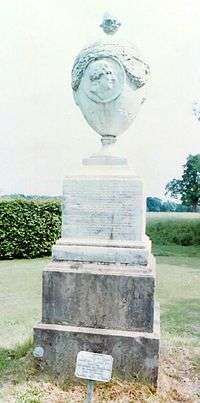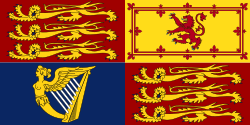Chevening

Chevening, also known as Chevening House, is a large country house at Chevening in the Sevenoaks District of Kent, in south east England. It is an official residence of the British Foreign Secretary. It was built in the 1620s to designs reputedly by Inigo Jones, and is a Grade I listed building.[1] The surrounding gardens, pleasure grounds and park are listed Grade II*.[2]
During the last coalition government, the Foreign Secretary and the Deputy Prime Minister shared use of the property.[3] In this Theresa May government, Foreign Secretary Boris Johnson will share the residence with Cabinet Colleagues David Davis and Liam Fox.[4]
History
The 115-room mansion, situated near a lake in the midst of a 3,500-acre (1,400 ha) estate, is a three-storey, symmetrical red brick structure in the English Renaissance style. It may have been designed by 17th-century British architect Inigo Jones. Staying there as a guest in 1911, the former Prime Minister Lord Rosebery crossed out "Chevening" at the head of a piece of writing paper and substituted "Paradise".[5]

The house was the family seat of the Earls Stanhope, and was bequeathed to the Nation by the 7th and last Earl Stanhope. He left the heavily endowed manor to be managed by a body of trustees. The Chevening Estate Act 1959 stipulated[6] that the future resident should be the Prime Minister, a Cabinet Minister, the widow or lineal descendant of King George VI, or the spouse, widow or widower of such a descendant.
Lord Stanhope was apparently impressed by the young Charles, Prince of Wales, and hoped that he would reside at Chevening. In 1974, the Prince accepted the prospect of living on the estate. According to his biographer, Jonathan Dimbleby (for whom Prince Charles himself arranged access to unpublished royal diaries and family correspondence), at that time he was contemplating an eventual marriage to Hon. Amanda Knatchbull, granddaughter of his great-uncle the 1st Earl Mountbatten of Burma: "[I]n 1974, following his correspondence with Mountbatten on the subject, the Prince had tentatively raised the question of marriage to Amanda with her mother (and his godmother) Patricia Brabourne. She was sympathetic, but counselled against raising the issue with her daughter, who had yet to celebrate her seventeenth birthday."[7] Amanda's paternal great-aunt had been Lady Eileen Browne, daughter of the 6th Marquess of Sligo, whose childless marriage to the last Earl Stanhope (who had no other near relations) led to Chevening being placed at the disposal of the Royal Family. If Amanda were to become Princess of Wales, the Prince's acceptance of Chevening would make some familial sense.
But this was not to be, although the Prince did visit the house several times. In a note of 24 April 1978 to his private secretary, Sir David Checketts, Prince Charles observed, "I know there are advantages – particularly financial ones – in the Chevening set up, but I regret to say I am rapidly coming to the conclusion that they are the only advantages."[8] In June 1980 Prince Charles wrote to Margaret Thatcher to renounce residency at Chevening (without actually having resided there). Weeks later, he purchased Highgrove House in Gloucestershire. By then, according to Dimbleby, Amanda Knatchbull had declined the Prince's proposal of marriage,[9] and he would soon begin courtship of Lady Diana Spencer.[10]
Since then, Chevening has been used by the British government to house successive Foreign Secretaries. However, William Hague and Philip Hammond, both of whom served as Foreign Secretary in the first Cameron ministry, shared the use of Chevening with Nick Clegg, the last Deputy Prime Minister.[3] David Davis and Liam Fox will share Chevening with Foreign Secretary Boris Johnson when hosting official events as Secretary of State for Exiting the European Union and Secretary of State for International Trade, respectively.[11] As a result it has acquired the nickname Brexit Towers[12]
Literary connection
It has been suggested that Chevening and its former parsonage are the inspiration for Rosings Park, home of Lady Catherine de Bourgh, and the Hunsford rectory in Jane Austen's Pride and Prejudice. Austen stayed with her relations in the area in 1795–6 while she was writing the first version of the book. Later her cousin, John Austen, became the rector at Chevening from 1813.[13]
See also
- Chequers, The British Prime Minister's official country retreat, near Wendover in Buckinghamshire.
- Dorneywood, A country retreat in Burnham, Buckinghamshire, periodically assigned to a senior British government minister.
References
_after_Thomas_Badeslade_(d.1742)%2C_published_(in_History_of_Kent)_1719_by_John_Harris.jpg)
- ↑ "Chevening House". English Heritage list. English Heritage. Retrieved 21 July 2014.
- ↑ "Chevening House". English Heritage list. English Heritage. Retrieved 21 July 2014.
- 1 2 Sparrow 2010.
- ↑ Hurd, Judy (14 September 2006), Country Life.
- ↑ http://www.legislation.gov.uk/ukpga/Eliz2/7-8/49/contents
- ↑ Dimbleby 1994, p. 263.
- ↑ Dimbleby 1994, p. 299.
- ↑ Dimbleby 1994, p. 265.
- ↑ Dimbleby 1994, p. 279.
- ↑ "Boris Johnson to share country residence with Cabinet colleagues David Davis and Liam Fox.", The Telegraph, retrieved 18 July 2016
- ↑ http://www.nytimes.com/2016/09/01/world/europe/britain-brexit-eu.html?smid=tw-nytimes&smtyp=cur&_r=0
- ↑ Halperin, John (1989), "Inside Pride and Prejudice", Persuasions, Jane Austen Society of North America (11), retrieved 2 March 2013
Bibliography
- Dimbleby, Jonathan (1994). The Prince of Wales: A Biography. New York: William Morrow & Co. ISBN 0-688-12996-X.
- Newman, Aubrey (1969). The Stanhopes of Chevening. Macmillan. ISBN 0-333-06054-7.
- Sedgemore, Brian (1995). The Insider's Guide to Parliament. Cambridge: Icon. ISBN 1-874166-32-3.
- Sparrow, Andrew (18 May 2010). "Nick Clegg and William Hague to share country house". The Guardian. London. Retrieved 18 May 2010.
External links
| Wikimedia Commons has media related to Chevening House. |
Coordinates: 51°17′56″N 0°07′53″E / 51.2990°N 0.1314°E

.svg.png)